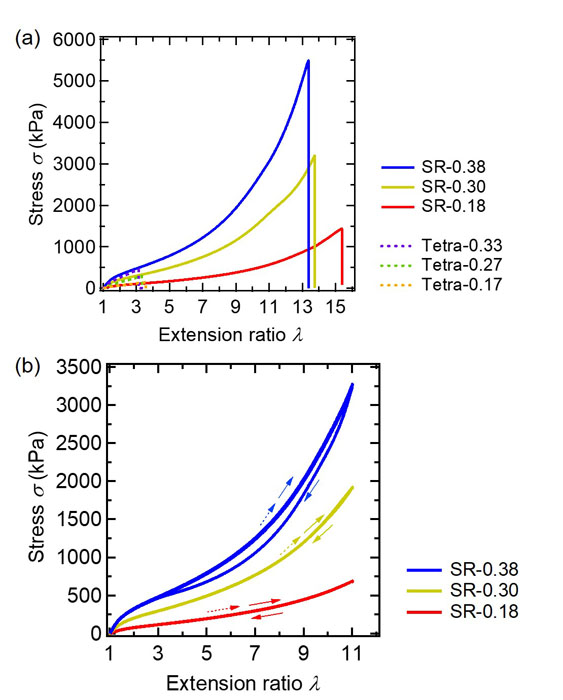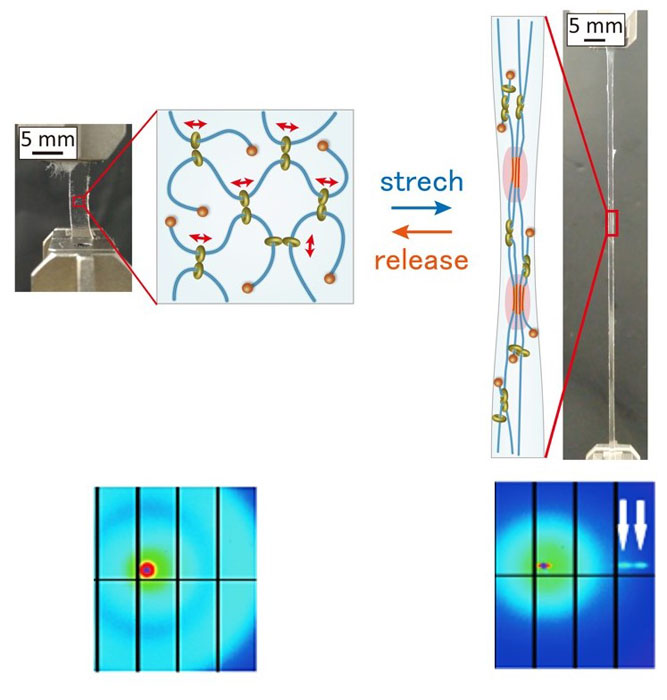Tough and Highly Recoverable Hydrogel Reinforced by Strain-Induced Crystallization
Mayumi Group
Hydrogels, cross-linked polymer networks containing water, are expected to be applied for biomaterials such as artificial cartilage, ligaments, and prosthetic joints due to their high water content and biocompatibility. For the applications as the biomaterials, the mechanical toughness and instant recoverability are needed because artificial ligaments and prosthetic joints should survive under repeated high stress at a high frequency (ex. 1 Hz). Most tough hydrogels are reinforced by introducing sacrificial structures that can dissipate input energy [1]. However, since the sacrificial damages cannot recover instantly, the toughness of these gels drops substantially during consecutive cyclic loadings. In this work, we have developed for the first time a tough and instantly recoverable hydrogels utilizing strain-induced crystallization (SIC) [2].
We used slide-ring (SR) gel containing movable figure-of-eight cross-links that work as pulleys to eliminate stress heterogeneities during deformation. SR hydrogel was prepared from polyrotaxane in which only 2 % of its polyethylene glycol (PEG) axis was threaded with a-cyclodextrin (CD) rings. The CDs are covalently cross-linked by adding cross-linkers. The slidable cross-linking points in SR gels can slide on the PEG chains to homogenize stress in the polymer network. For comparison, fixed cross-link PEG gels were prepared via end-crosslinking of Tetra-armed PEG prepolymers. The PEG concentrations and molecular weights of polymer strands between cross-linking points in the Tetra gels were almost the same as those in the SR gels.
Fig. 1 (a) shows the tensile stress–extension ratio curves until rupture for the SR and Tetra gels. The SR gels can survive at higher stress (> 5 MPa) and higher strain (> 1000%) compared with the Tetra-PEG gels. The toughness of the SR gels is comparable to that of the most tough polymer gel with the breakable sacrificial structure. Also, as shown in Fig.1 (b), the mechanical hysteresis of the SR gels under repeated cycle is quite small, and the instant recovery of extension energy between two consecutive cycles is 95 %, which is much higher than the low recoverability of the tough polymer gels having breakable structure (< 50%).
The high toughness of the SR gels originates from strain-induced crystallization (SIC). As shown in Fig. 2, at large strains, we observed diffraction spots in the wide-angle X-ray scattering (WAXS) patterns, indicating the occurrence of SIC of the stretched PEG chains. On the other hand, no diffraction spots were observed for the Tetra gels. The slidability of the cross-liinking points homogenizes the orientation and deformation of PEG chains, which results in the remarkable high toughness of the SR gels. During the unloading process, the strain-induced crystalline structure disappeared immediately. The reversible formation/destruction of the PEG crystals under repeated cycles leads to the high mechanical reversibility of the SR gels.
Although SIC has been reported in rubbers without any solvent, it is the first time to discover the reversible SIC in polymer gels with much lower polymer concentrations. This self-reinforcement strategy by SIC is a novel concept for realizing simultaneously high mechanical toughness and rapid recoverability under cyclic deformation, which are required for the biomedical materials for artificial joints and ligaments.
References
- [1] J. P. Gong, Soft Matter 6, 2583 (2010).
- [2] C. Liu, N. Morimoto, L. Jiang, S. Kawahara, T. Noritomi, H. Yokoyama, K. Mayumi, K. Ito, Science 372, 1078 (2021).


